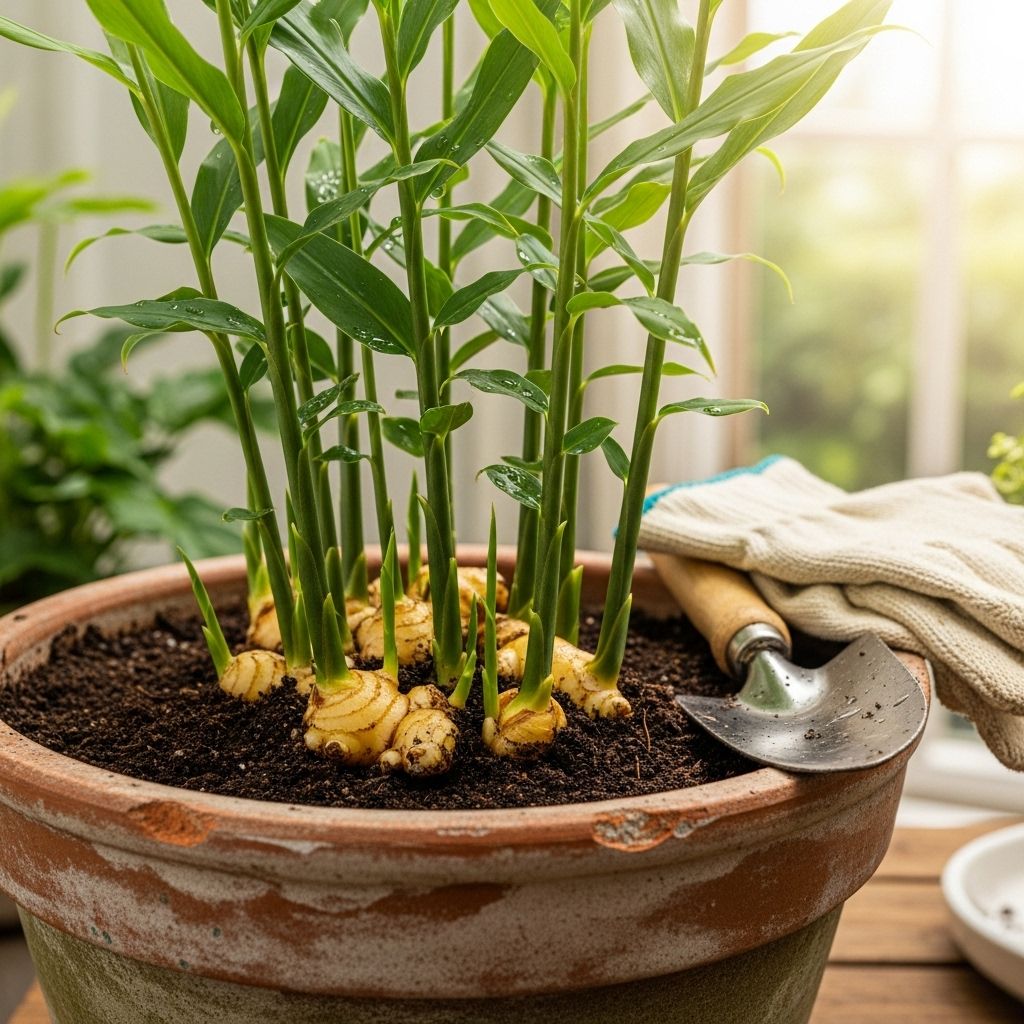15 Expert Tips for Growing Ginger Successfully in Containers
A humid, warm corner and the right soil mix can yield vibrant growth all season long.

Ginger (Zingiber officinale) is both a delicious spice and a strikingly attractive foliage plant, but it’s not always feasible to grow it in the ground—especially for those in cool or temperate climates. Luckily, with the right care, ginger thrives in pots and containers. This comprehensive guide shares 15 essential tips and insights for growing vibrant, healthy ginger wherever you live, whether outdoors on a patio or inside a bright, humid room.
Why Grow Ginger in Containers?
There are many advantages to growing ginger in containers:
- Mobility: Easily move plants indoors when temperatures drop, protecting tropical ginger from frost damage.
- Climate Control: Maintain warm, humid conditions more reliably than in open beds—key to ginger’s success.
- Convenient Harvesting: Harvest rhizomes without disturbing the whole plant or garden, and even take ‘baby ginger’ as needed.
- Space Efficiency: Ideal for small patios, balconies, or indoor gardening enthusiasts with limited yard space.
Understanding Ginger’s Growing Needs
Ginger is a tropical perennial that flourishes in conditions similar to its native rainforest habitats. To grow robust ginger in containers, mimic these environmental factors as closely as possible:
- Warmth: Prefers 70–90°F (21–32°C).
- High Humidity: Thrives at 70–90% humidity; hates dry indoor air.
- Moist, well-draining soil: Needs consistent moisture, never soggy or completely dry.
- Filtered sunlight: Enjoys dappled or bright indirect light; avoid strong midday sun.
15 Tips for Growing Amazing Ginger in Containers
1. Choose the Right Ginger Rhizome
Only ginger rhizomes (not seeds) produce new plants. Select plump, healthy, organically grown rhizomes—look for visible ‘eyes’ or buds. Grocery store ginger often works, but ensure it hasn’t been treated with growth inhibitors. Let rhizomes sit in water overnight to jumpstart bud development before planting.
2. Pick the Best Container
- Wider is better than deeper: Shallow, wide containers allow rhizomes to spread and multiply horizontally, boosting yields.
- Size: Minimum 12–16 inches wide and 12 inches deep per plant.
- Material: Clay, ceramic, plastic, or fabric pots work well if they have drainage holes.
3. Use Proper Potting Mix
Ginger craves rich, slightly acidic, well-draining soil. Use a high-quality mix containing coconut coir or peat, compost or rotted manure, and added perlite or sand for aeration. Homemade mix: 1 part compost, 1 part coconut coir, 1 part perlite/sand.
4. Don’t Bury Rhizomes Deeply
Plant each rhizome piece with buds pointing up, just 1–2 inches under the surface. The roots will form beneath, and new shoots develop above the soil.
5. Provide the Right Light
- Indoors: Place next to a sunny window with filtered light, or use a bright grow light.
- Outdoors: Choose a spot with morning sun and afternoon shade, or use shade cloth to filter harsh midday rays.
6. Water Carefully—Consistent, Not Soggy
Let just the soil surface dry slightly before watering again. Typically, water once or twice weekly, but increase frequency in hot or dry weather. Never let soil become bone-dry or waterlogged.
7. Maximize Humidity
- Ginger loves high humidity—70–90% is ideal.
- Use a humidifier or set the pot on a pebble tray with water indoors.
- Group plants together to create a microclimate.
- A sunny bathroom is an excellent indoor location.
8. Fertilize for Healthy Growth
Feed ginger every 4–6 weeks during active growth using a balanced liquid fertilizer or compost tea. A slow-release, organic fertilizer with moderate nitrogen supports foliage without sacrificing rhizome development.
9. Mulch to Retain Moisture
- Add a layer of organic mulch (like straw, leaf mold, or shredded bark) on top of the soil to hold moisture and regulate temperature.
- Reapply mulch during heat waves to prevent spikes in soil dryness.
10. Control Temperature
Keep ginger containers in consistently warm spots. Temperature dips below 55°F (13°C) slow growth. Move pots indoors if needed to avoid cold snaps or frost.
11. Prevent Pests and Disease
- Watch for: Spider mites, mealybugs, root rot, and fungal issues.
- Good air circulation, never-overwatered soil, and clean pots help prevent problems.
- Use organic insecticidal soap or neem oil at the first sign of trouble.
12. Allow Time—Ginger Is Slow to Mature
Ginger takes 8–10 months for mature rhizomes, but you can snip small pieces for ‘baby ginger’ harvests after 4–6 months. Harvesting earlier gives a milder product with tender skin.
13. How to Harvest Ginger
- Gently dig around the edge of the pot to pull a section of rhizome while leaving the rest to grow (for continuous harvest).
- For a full harvest, empty the pot and separate the new rhizomes from the parent. Brush off soil and set unused portions aside for replanting.
- Trim foliage after harvest and save a few choice sections for next season’s planting.
14. Overwintering and Extending the Season
- In cooler climates, bring pots inside to keep ginger actively growing year-round in warm rooms.
- Cut back dry stems but keep rhizomes in their pot and soil. Water sparingly until new shoots reappear in spring.
15. Repotting and Propagation
If your ginger outgrows its container or you see crowded rhizomes, gently divide and repot in fresh soil to reinvigorate plants and multiply your stock.
Frequently Asked Questions (FAQs)
Q: Can I grow ginger from supermarket ginger roots?
A: Yes, supermarket ginger rhizomes often sprout well. Choose pieces with healthy buds and organic is best to avoid growth inhibitors. Soak overnight and follow standard planting instructions for great results.
Q: How often should I water ginger in containers?
A: Water when the soil surface is slightly dry—typically once or twice a week, depending on climate and humidity. Adjust based on rainfall and pot size but avoid letting soil dry out completely or remain soggy.
Q: What kind of fertilizer works best for potted ginger?
A: Use a balanced liquid fertilizer or compost tea every 4–6 weeks during the growing season. Organic slow-release options with moderate nitrogen, phosphorus, and potassium give best results.
Q: How can I increase humidity for indoor ginger plants?
- Place pots on a tray with water and pebbles so the base is above the water line.
- Use a room humidifier nearby.
- Group plants together or grow in a sunny bathroom, which naturally has higher humidity.
Q: When and how do I harvest ginger from containers?
A: Wait at least 8 months for mature harvests, or 4–6 months for young ‘baby ginger’. Carefully remove sections from the edge of the pot as needed, letting the rest of the plant keep growing, or tip the pot and harvest whole rhizomes in late fall before cold weather.
Common Problems and Solutions
| Problem | Cause | Solution |
|---|---|---|
| Yellow leaves | Overwatering or poor drainage | Use well-draining soil and water only when surface is dry |
| Slow growth | Low temperature or too little light | Move to warmer, brighter spot; add grow lights |
| Root rot | Continuous soggy soil | Repot in fresh, dry soil; water less often |
| Rhizomes not expanding | Poor soil, overcrowding | Fertilize regularly and repot or divide annually |
Storing and Using Homegrown Ginger
Once harvested, keep whole, unpeeled ginger rhizomes in a cool, dry, dark spot or a paper bag. They last several weeks this way. For longer storage, peel, slice, or grate ginger and freeze in small batches. Ginger cubes frozen with a drop of water in ice cube trays are convenient for cooking, teas, and smoothies.
Final Thoughts
Container-grown ginger brings the lush beauty and bold flavors of the tropics right to your home or patio. Its shallow, spreading root system, need for warmth and humidity, and slow growth habit make it ideal for pots—especially in parts of the world where growing conditions outdoors aren’t ideal. Grow ginger for its culinary zing or simply for its exotic foliage; with these practical tips, you’ll enjoy fresh harvests from your very own container garden, year after year.
References
Read full bio of Srija Burman












